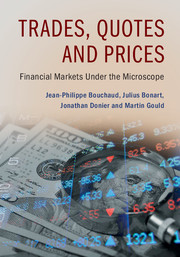Book contents
- Frontmatter
- Dedication
- Contents
- Preface
- Acknowledgements
- PART I HOW AND WHY DO PRICES MOVE?
- 1 The Ecology of Financial Markets
- 2 The Statistics of Price Changes: An Informal Primer
- PART II LIMIT ORDER BOOKS: INTRODUCTION
- PART III LIMIT ORDER BOOKS: MODELS
- PART IV CLUSTERING AND CORRELATIONS
- PART V PRICE IMPACT
- PART VI MARKET DYNAMICS AT THE MICRO-SCALE
- PART VII ADVERSE SELECTION AND LIQUIDITY PROVISION
- PART VIII MARKET DYNAMICS AT THE MESO-SCALE
- PART IX PRACTICAL CONSEQUENCES
- Appendix
- Index
- References
1 - The Ecology of Financial Markets
from PART I - HOW AND WHY DO PRICES MOVE?
Published online by Cambridge University Press: 26 February 2018
- Frontmatter
- Dedication
- Contents
- Preface
- Acknowledgements
- PART I HOW AND WHY DO PRICES MOVE?
- 1 The Ecology of Financial Markets
- 2 The Statistics of Price Changes: An Informal Primer
- PART II LIMIT ORDER BOOKS: INTRODUCTION
- PART III LIMIT ORDER BOOKS: MODELS
- PART IV CLUSTERING AND CORRELATIONS
- PART V PRICE IMPACT
- PART VI MARKET DYNAMICS AT THE MICRO-SCALE
- PART VII ADVERSE SELECTION AND LIQUIDITY PROVISION
- PART VIII MARKET DYNAMICS AT THE MESO-SCALE
- PART IX PRACTICAL CONSEQUENCES
- Appendix
- Index
- References
Summary
Buyer: How much is it?
Seller: £1.50.
Buyer: OK, I'll take it.
Seller: It's £1.60.
Buyer: What? You just said £1.50.
Seller: That was before I knew you wanted it.
Buyer: You cannot do that!
Seller: It's my stuff.
Buyer: But I need a hundred of those!
Seller: A hundred? It's £1.70 apiece.
Buyer: This is insane!
Seller: It's the law of supply and demand, buddy. You want it or not?
(Translated from “6”, by Alexandre Laumonier)A market is a place where buyers meet sellers to perform trades, and where prices adapt to supply and demand. This time-worn idea is certainly broadly correct, but reality is rather more intricate. At the heart of all markets lies a fundamental tension: buyers want to buy low and sellers want to sell high. Given these opposing objectives, how do market participants ever agree on a price at which to trade?
As the above dialogue illustrates, if a seller was allowed to increase the price whenever a buyer declared an interest to buy, then the price could reach a level so high that the buyer was no longer interested – and vice-versa. If traders always behaved in this way, then conducting even a single transaction would require a long and hard negotiation. Although this might be feasible if trades only occurred very infrequently, modern financial markets involve many thousands of transactions every single day. Therefore, finding a mechanism to conduct this process at scale, such that huge numbers of buyers and sellers can coordinate in real time, is an extremely complex problem.
Centuries of market activity have produced many possible solutions, each with their own benefits and drawbacks. Today, most markets implement an electronic, continuous-time double-auction mechanism based on the essential idea of a limit order book (LOB), which we introduce in Chapter 3. However, as a brief glance at the financial press will confirm, ensuring market stability and “fair and orderly trading” is still elusive, and it remains unclear whether modern electronic markets are any less prone to serious problems than old-fashioned trading pits.
- Type
- Chapter
- Information
- Trades, Quotes and PricesFinancial Markets Under the Microscope, pp. 5 - 21Publisher: Cambridge University PressPrint publication year: 2018

